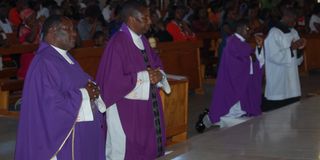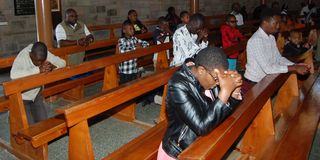How Covid-19 will change ways of worship in Catholic churches

Catholic priests conduct mass at Christ The King Cathedral in Nakuru town on March 22, 2020. PHOTO | FRANCIS MUREITHI | NATION MEDIA GROUP
What you need to know:
- On liturgical requirements, all missalettes, hymnals, prayer cards and other paper resources must be removed from pews.
- The popular sign of peace by hand greeting will be replaced to avoid physical contact.
- The kissing of the altar and the gospel by the celebrant priests will be replaced by deep or profound bow.
The Catholic Church in Kenya will break away from the traditional way of worship, thanks to Covid-19 pandemic.
This is the first time that the church with more than 12 million members is changing its ways of worship without much consultations from the Vatican.
The church has an elaborate procedure of celebrating Eucharist established under the Canon Law, or the law of the Catholic Church which is religiously followed worldwide.
However, over 2,000 priests in more than 26 dioceses in about 1,500 parishes across the country will now change the way they preach and conduct other ceremonies such as sacrament, baptism, funerals, weddings and confessions.
EDUCATIONAL INSTITUTIONS
The new mode of worship will also affect over 2,000 educational institutions, several pastoral centres, shrines, retreat centres, hospitals and children’s homes among other institutions owned by the church.
The guidelines come at a time when the government appointed Inter-Faith Council led by Nyeri Catholic Archbishop Anthony Muheria is burning the midnight oil to compile guidelines to be followed ahead of reopening of places of worship.
The 16-member council is expected to come up with protocols for celebrations of weddings, funerals and other religious ceremonies in the places of worship.
The religious groups are also expected to ensure strict Covid-19 containment measures like physical and social distancing guidelines issued by the Ministry of Health are observed.
At least more than 7,188 Kenyans have so far contracted the disease while 154 others have succumbed to the virus.
According to the guidelines issued by the Kenya Conference of Catholic Bishops, dubbed “Liturgical Guidelines on the Re-opening of Public worship” the way church services are conducted will never be the same again.
RESPONSIBLE WORSHIPING
The church has proposed a raft of measures to ensure safe and responsible worshiping in tandem with the Ministry of Health strict guidelines ahead of the reopening of places of worship.
During the sacrament of baptism, the priest should wear a mask throughout the celebration of the sacrament and strictly observe 1.5 meter-distance.
“A limited period of proximity during the anointing, the pouring of water, and explanatory rites is permissible and necessary,” said the eight-page report signed by the chairman of Kenya Conference of Catholic Bishops Reverend Philip Anyolo.

Catholic faithful worshipping at Christ The King Cathedral in Nakuru town on March 22, 2020. PHOTO | FRANCIS MUREITHI | NATION MEDIA GROUP
The anointing associated with the sacrament of confirmation may not take place via the use of cotton ball or other instrument.
“The anointing must be performed by the celebrant directly with his hand,” said the guidelines.
The sacrament of anointing the sick during this pandemic period will be restricted to those who are dying and those about to undergo serious surgery and will be conducted only by trained hospital chaplains who wear Personal Protective Equipment (PPE).
SOCIAL DISTANCING
The guidelines reveal how the sacrament of confession should follow safe social distancing practices and be carried in a well-ventilated area, outdoors, or in the main church.
“Both the priest and the penitent should wear masks and impermeable barrier should be placed between the priest and the penitent,” states the guidelines.
The holy water fonts placed at the entrance of the church should remain emptied while blessed water is to be properly disposed of in a scacrarium or directly into the ground.
On liturgical requirements, all missalettes, hymnals, prayer cards and other paper resources must be removed from pews. At the same time, mass will be celebrated for one hour and where there are more masses, there will be an interval of 30 minutes to ensure sanitising.
For rural set up, the guidelines encourages faithful to celebrate Sunday masses in the small Christian communities.
NUMBER OF USHERS
Other measures include reducing the number of ushers, choir members, altar servers, processional dances. The use of microphones should be restricted to one priest or if used by more than one it should be sanitised.
The priests are encouraged to use own chalice while drinking the symbolic blood of Christ.
The popular sign of peace by hand greeting will be replaced to avoid physical contact. The kissing of the altar and the gospel by the celebrant priests will be replaced by deep or profound bow.
“By giving these guidelines, we are confident that we can assure our Christians of their safety when attending the church services. We shall continue working with the government and the Ministry of Health officials to realise the goal of bringing back the church activities to the catholic community responsibly and expeditiously,” said the guidelines.





